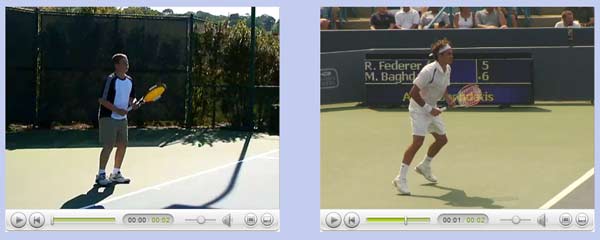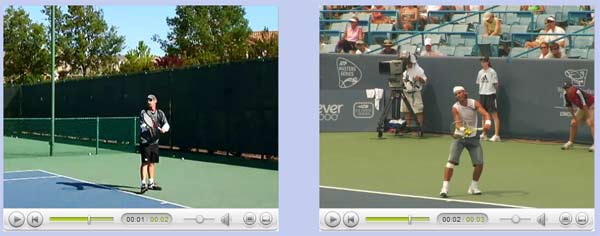|
TennisOne Lessons Comparative Stroke Analysis Jim McLennan Over the years I have had many an opportunity at tennis teacher’s conferences to observe the methods and materials of my colleagues. And certainly our teaching practice is as much an art as a science, if perhaps even more of the former than the latter. But our teaching efforts are first and foremost determined by our observations. Analysis then follows observation, but at the outset it begins with what we (the teachers) see. In a scientific framework, experiments begin with a hypothesis or hunch, and then move on to the measurement of observable evidence, then to an interaction with this evidence, and then another measurement to see if a change has occurred. Well, we do a version of this, which again verges between art and science. But as regards observation, I am never really sure that if a student presented a one-handed backhand (for example) to a group of tennis professionals, whether the professionals would agree, first on their observations, and then on potential interventions. On this score, some years ago at a tennis conference in Santa Rosa, I presented a video of a 3.5 player’s serve to a large group of professionals. In the ensuing discussion it became apparent that the coaches didn’t even agree on what they had seen, even though they were all looking at the same video clip. Interesting. So we (tennisOne) have an incredible tool with the TennisOne Video Network, called the Stroke Comparison Channel. You can upload a video of any particular stroke, and place that upload side by side with a tennis pro at a similar angle. And you have a first hand opportunity to observe the similarities and differences between yourself and any number of the best players in the world. And you can share this comparison with your coach. But, and here is the caveat, and what I propose to do in subsequent articles. More than how the stroke looks, there must be information about the player’s game. Have there been injuries? Does the stroke lack power? Do you play an offensive or defensive game? For when armed with this information a tennis teacher can more clearly evaluate the comparative images. So truly, the call to action is for you to send an example of a one-handed backhand, a volley (either forehand or backhand) and a second serve. And I will go out on a limb and share my observations with you and the world, to allow you to see how we (or in this case I) go about in the initial stage of this teaching thing – which is simply observation. I will only select one example of each stroke; there is no charge for this as I want to share with all readers how truly great the stroke comparison channel can be for you. But, and this is most important – all upload submissions for this “contest” if you will, must include information about your personal style, past injuries, and feel for power and consistency. Stroke Comparison Channel The following examples are done without the added information, but they will give you an idea of how you can use this Stroke Comparison Channel. In the example above, comparative two-handed backhands are hit from out wide in the court. If possible I would ask a number of questions of the “junior girl.” Including – where are you normally positioned to return the second serve? Do you characterize your style as offensive or defensive? Are there any particular areas in your game or your backhand that you wish to improve? Those answers might shape the nature of my observations, or actually help me to see something that I might otherwise miss. But that said, she appears to use a shuffling footwork to get to the ball, whereas Ivanovic has turned her hips to run rather than shuffle. And if the “junior girl” had mentioned anything about movement or court coverage then I would look to see how her movement in general appeared about court. Her posture and balance during the hit are excellent. She uses both legs to drive her hips and body into the swing, and she keeps her head totally still at contact. So in this example there is much more that is “right than wrong.” If she had asked about more power, however, note how Ivanovic waggles the racquet head as it approaches the ball, whereas she waggles the racquet at the end of the backswing. To my eye this is the most telling difference in the swing, where Ana appears much more fluid, but certainly that is what we would expect, and what the “junior girl” and all of us should strive for. For more information on the lag or waggle, refer to any and all articles on the Andre Agassi backhand. Comparison Two In the comparison between Roger Federer and the junior boy I notice both a number of similarities and differences. I suspect this young man trusts his forehand, his swing appears free, he uses his body to generate pretty good racquet speed, and more than likely his forehand is his preferred weapon. Both prepare by turning to the side, establishing their weight on the back foot and both have the racquet head well up. Please note this is not the normal “racquet back” we so often hear about but rather a turn to the side without much racquet commitment. Further, both place their non dominant arm in nearly identical positions a, much like baseball pitchers and quarterbacks, the non dominant arm plays an important role in the timing and mechanics of the forward turn into the ball. Though this may be harder to see, Roger’s racquet approaches the ball from a lower position than the Junior Boy, and further, Roger finishes with his hitting elbow much lower, whereas the junior boy finishes more conventionally “up.” Somehow many of the modern players finish with a much lower arm movement that we might expect, but perhaps over time the Junior Boy will also develop that option. Finally, both shift their weight nicely into the ball, and both continue their shoulder turn through and after the hit. Overall Roger takes many more small and quick positioning steps, though I suspect the Junior Boy was simply hitting on a ball machine, and just prior to the hit Roger has a wider stance or base, whereas the kid has his feet ever so slightly together. Comparison Three Finally, Pro 2 and Nadal provide a picture of similar service actions. The camera angles are nearly identical. Serving rhythm appears identical, in that neither use an overly high toss or an overly deep knee bend, and both move their back foot forward during the motion. My hunch is that Pro 2 has a fairly reliable serve with good pop and relatively little effort. The only way a teacher could get involved here would be with a series of questions, including: Can you serve both sidespin and kick? If your serve goes off are you making errors of height or width? What type of spin do you use on your second serve? Is your first serve hit flat or with spin? Then with Pro 2, using additional camera angles, we could take a deeper look into the motion. Note with Nadal’s delivery, he does not vary the spin or placement, serves few aces, but in most instances is serving at or near 75% first serves. And with his wicked forehand as the finishing blow to all poorly hit returns, his serve is a weapon because of placement and consistency rather than brute power (Roddick) or disguise (Federer). So take some time with the Stroke Comparison Channel. And if you are willing to have your strokes compared with professional models, and are willing to answer specific questions about your game – upload your video, and, if selected, I will share this comparative stroke analysis tool with you and the world. For the observations will be published in the subsequent article. Your comments are welcome. Let us know what you think about Jim McLennan's article by emailing us here at TennisOne.
|
||||||||||||




